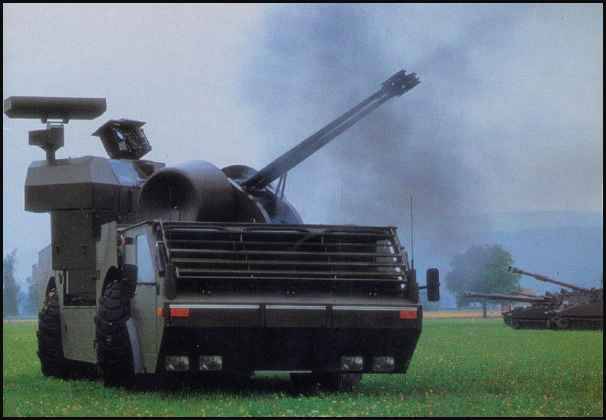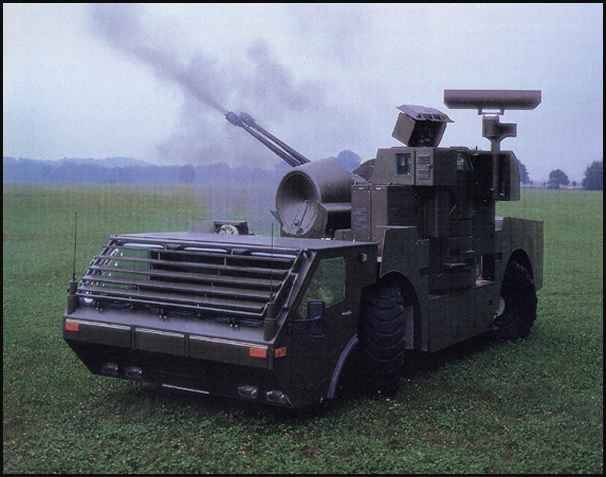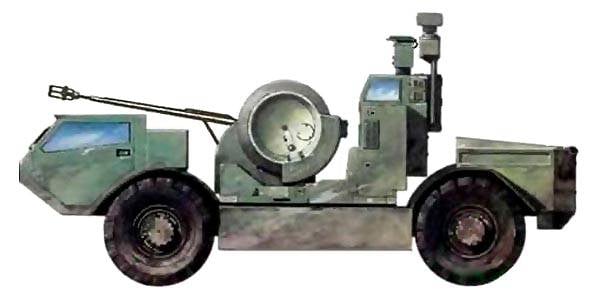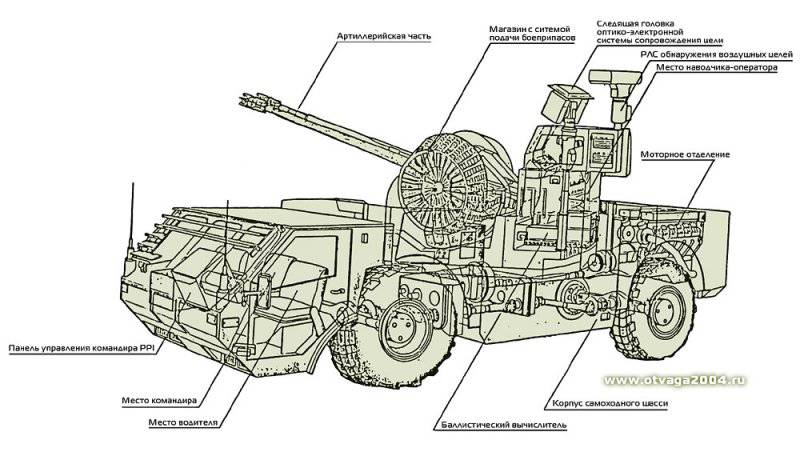Project of self-propelled anti-aircraft installation Oerlikon Escorter 35 (Switzerland)

According to the specification of the ZSU Escorter 35, it had to have its own radar for detecting and tracking targets, an electronic fire control system and two automatic guns of the 35 caliber mm. The maximum range of destruction of air and ground targets was set at the level of 4 km. It was assumed that the car will be able to use the road network and quickly move to the desired area along the existing roads. Self-propelled gun was supposed to protect the troops on the march and in places of concentration.
The Escorter 35 project involved the creation of an anti-aircraft self-propelled gun (ZSU) based on the existing artillery system. New anti-aircraft self-propelled was supposed to offer foreign customers, which affected the technical appearance of the project. In the new machine it was proposed to use existing components that could simplify and speed up the construction of anti-aircraft self-propelled guns. For example, for this reason, in the basic version of the ZSU Escorter 35 received a wheeled chassis, created by the German company Hydrokrane.
It should be noted that the wheeled chassis, losing track by tracked, could, to a certain extent, restrict the mobility of the prospective ZSU, but this was considered an acceptable price for comparative simplicity and low cost. In addition, the very fact of using a self-propelled chassis provided great advantages over towed GDF-001 systems.

The basis of the ZSU Escorter 35 was the chassis with the wheel formula 4х4. In front of the base vehicle, there was a three-seater cabin with driver and commander jobs. In addition, when moving the car to a new position in the cockpit could be an operator of anti-aircraft systems. During the shooting, the cabin could go down and down, increasing the allowable pointing angles. In the middle part of the chassis there was a platform for the installation of an artillery unit, in the stern - the engine compartment. The Escorter 35 self-propelled gun received a hp 455 diesel engine. The cockpit, artillery module and engine compartment were protected by bulletproof armor.
An interesting feature of the used chassis was the design of the wheeled chassis. All four wheels mounted on an independent hydropneumatic suspension, were not only leading, but also manageable. The control mechanisms made it possible to deflect the front and rear wheels in different directions, thanks to which the minimum turning radius reached 6,2 m with the length of the 8,5 machine. With simultaneous rotation of all the wheels in one direction, the zenith self-propelled gun could move at an angle to its longitudinal axis. Depending on the road conditions, the crew could regulate tire pressure.
The Escorter 35 machine turned out to be quite heavy - its combat weight was equal to 24 tons. The dimensions of the anti-aircraft self-propelled gun were determined by the size of the used chassis. Its length in the stowed position was equal to 8,5 m, with a lowered cab - 9,2 m. The width of the car - 2,98 m, the maximum height of the base machine (with a raised cab) - about 2,5 m. The used engine provided the maximum speed on the highway to 120 km / h. Power reserve - 600 km.
Armament and fire control equipment were placed on a turntable, which, in turn, was located on the middle platform of the base chassis. In front of the platform, there were guns with an ammunition system, in the rear — an operator's cabin and electronic equipment.
Armament ZSU Escorter 35 consisted of two automatic guns GDF-D03, representing a modified version of the gun GDF-001. During the modernization of the rate of fire of guns was increased to 600 shots per minute. As before, the gun used the recoil energy of the barrel to reload. The design of both anti-aircraft self-propelled guns was identical, but carried out "mirror". This made it possible to place the cannons nearby, and on their sides to install shops and projectile delivery systems. The gun carriage made it possible to direct them in a vertical plane ranging from -5 ° to + 85 °.
On the sides of the barrel GDF-D03 guns were two shops of the original design. The store was a drum with 25 cells for clips, closed armored casing. A cage with 8 shells of the same type was placed in each of the drum cells. This method of loading allowed not only to provide the required firepower, but also to quickly replace the type of ammunition used. Automatics took into account what type of shells was in one or another of the cages and, at the operator’s command, let the cell with the desired cage down to the ammunition supply system in the gun. This made it possible to quickly and easily change the type of ammunition used in the next stage.
The standard ZSU Escorter 35 ammunition was to consist of 430 shells of various types. For 200 shells (25 clips for 8 shells) were charged in stores and two clips on 15 shells each had previously been placed directly into the ammunition supply system. The anti-aircraft ammunition consisted of several types of 35x228 mm shells. Depending on the task, the guns could use fragmentation-incendiary, semi-armor-piercing-incendiary and armor-piercing sabot projectiles. Ammunition of all types was equipped with a tracer. The shells of the first two types were intended for firing at air targets and had an initial speed at the level of 1175 m / s. Armor-piercing podkalibernye left the barrel at a speed of 1385 m / s and were intended for firing at ground equipment.
According to some reports, in the future, the Escorter 35 self-propelled self-propelled gun could get a projectile with a programmable fuse that can significantly improve the effectiveness of firing at air and ground targets. The specific composition of the ammunition and the number of shells loaded into the drum of one type or another should be determined in accordance with the tasks.

To monitor the airspace and detect targets, the Escorter 35 ZSU was supposed to use a Doppler-type radar station developed by Contraves based on the ADATS radar. Some changes have been made to the design of this station. In particular, it received a smaller antenna. The radar detection and tracking could track targets at a distance of 20 km. Provided simultaneous maintenance of up to six goals. By reducing the side lobes of the antenna pattern, the station could follow low-altitude targets.
Information about the observed targets was displayed on the workplace of the vehicle commander in the front cockpit. The commander could independently determine the order of attack of the target or transfer this duty to automation. After determining the priority goal, a turnaround was made. weapons in the direction of the goal, and she was taken to support the optical-electronic system.
The optoelectronic equipment unit, like the radar antenna, was located on the roof of the operator’s cabin. This unit was equipped with an infrared tracking system, a laser rangefinder and a periscope sight with an eightfold magnification and a field of view 8 ° wide. With the automatic tracking of the target, an infrared tracking system was used, with a manual operator the operator had to observe the target with a periscopic sight. During the operation of the automation operator could interfere with its work. In addition, in the event of a support breakdown, he had to manually produce a new capture.
The calculation of the corrections for firing, taking into account the location of the target, the range to it, the type of selected ammunition and weather conditions was assigned to the ballistic computer, borrowed from the ADATS complex without any changes. Shooting began at the command of the operator. The minimum reaction time, from target detection to the first shot, was 5 seconds.
The standard regime of fire on air and ground targets was firing bursts at 15-16 shots (2 clips) with a duration of about 1,5 with. The maximum range to the target at which the defeat was secured reached 4 km. Fragile incendiary and semi-brutal fragmentation incendiary projectiles flew to the maximum range around 6 s, armor-piercing sabot tracer - 4 s. The latter, at a meeting angle of 90 °, could penetrate up to 80 mm of armor.
The prototype of the self-propelled anti-aircraft installation Escorter 35 was built in 1984-85's. The presentation of the project took place in 85. The promotional materials mentioned high combat characteristics of the new complex, as well as its relatively low cost. In particular, the ZSU Escorter 35 with a clear result was compared with other modern systems of similar purpose. It is known that one of the Middle Eastern countries became interested in the new anti-aircraft self-propelled gun. In 1986, a prototype was delivered to this country for testing at a potential customer site. The results of these tests are unknown, but the contract for the supply of new anti-aircraft systems has not been signed.
In the second half of the eighties, Oerlikon developed a new version of the Escorter 35 project that differed from the base chassis. To increase mobility and terrain, this self-propelled version had to use a tracked chassis, developed on the basis of the M548 armored personnel carrier (a modification of the American M113). On a tracked chassis, it was planned to mount a three-seat cockpit and a turntable with weapons and electronic equipment. The artillery unit and electronics did not differ from those developed in the framework of the first project of the Escorter 35.
Both options ZSU Escorter 35 not interested potential customers. The exact reasons for this are unknown. However, based on the groundwork for an anti-aircraft self-propelled gun project, the towed GDF-005 system was soon created. This anti-aircraft gun is equipped with two 35 mm caliber guns with equipment for using projectiles with a programmable fuse. In addition, to ensure the operation of artillery installations, the customer can purchase a Skyguard control module. This system is a towed trailer with operator's cab, radar and fire control equipment similar to that used on the Escorter 35 ZSU. Unlike self-propelled guns, which did not interest potential buyers, towed GDF-005 systems were supplied in more than three dozen countries.
On the materials of the sites:
http://otvaga2004.ru/
http://alternathistory.org.ua/
http://dogswar.ru/
http://secretprojects.co.uk/

Information